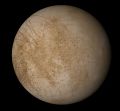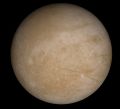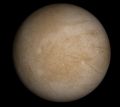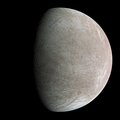Difference between revisions of "Europa"
(Added gallery image.) |
(Added image.) |
||
| Line 63: | Line 63: | ||
EuropaOrbiter2002.jpg|<center>'''Europa in Orbiter 2002'''</center> | EuropaOrbiter2002.jpg|<center>'''Europa in Orbiter 2002'''</center> | ||
Europa-orbiter2002p3.jpg|<center>Europa in Orbiter 2002P3</center> | Europa-orbiter2002p3.jpg|<center>Europa in Orbiter 2002P3</center> | ||
| + | Europa-Orbiter2003P2.jpg|<center>Europa in Orbiter 2003P2</center> | ||
Europa in natural color.png|Europa as seen by the [[w:Juno (spacecraft)|Juno spacecraft]] | Europa in natural color.png|Europa as seen by the [[w:Juno (spacecraft)|Juno spacecraft]] | ||
Galilean moon Laplace resonance animation 2.gif|<center>Animation of three inner Galilean moons showing orbital resonance</center> | Galilean moon Laplace resonance animation 2.gif|<center>Animation of three inner Galilean moons showing orbital resonance</center> | ||
Revision as of 02:49, 8 September 2024
Europa is one of Jupiter's four Galilean Moons. It is thought that there may be simple life, such as bacteria, on or under it's icy surface, and this was one of the contributing factors in NASA's decision to crash the Galileo Probe into Jupiter, out of fear that bacteria could contaminate the potential oceans of Europa. Europa's orbit is in a 1:2:4 resonance with Io and Ganymede.
Europa in Orbiter
Europa was introduced in Orbiter 2002 modeled as a sphere with a mass of 4.8×1022 kg and a radius of 1.565×106.
Orbiter versions and add-ons which include Europa as a body.
| Add-on | Source | Version | Author | Type | Release Date | Compatibility | Wiki article |
|---|---|---|---|---|---|---|---|
| Orbiter 2003-P2 | O-F Resources | 031217 | martins | Orbiter Download | 17 December 2003 | Orbiter 2003-P2 | |
| Orbiter 2003-P1 | O-F Resources | 031105 | martins | Orbiter Download | 5 November 2003 | ||
| Orbiter 2002 | O-F Resources | 020419 | martins | Orbiter Download | 19 April 2002 | Orbiter 2002 | |
See also
Europa as seen by the Juno spacecraft
| edit The Solar System | |
|---|---|
| Central star |
Sun (Sol) |
| Planets |
Mercury - Venus - Earth - Mars - Jupiter - Saturn - Uranus - Neptune |
| Natural satellites |
Moon - Phobos - Deimos - Io - Europa - Ganymede - Titan - more... |
| Add-ons |
Planets - Dwarf Planets - Small objects - Natural satellites - Alternative star systems |
 | This natural satellite related article is a stub. You can help Orbiterwiki by expanding it.
|





